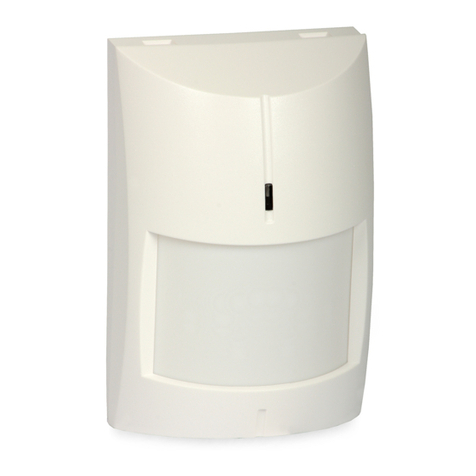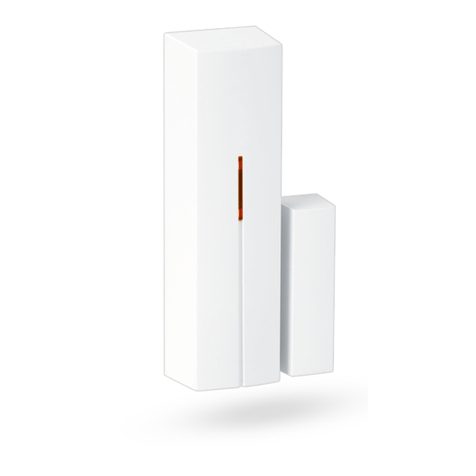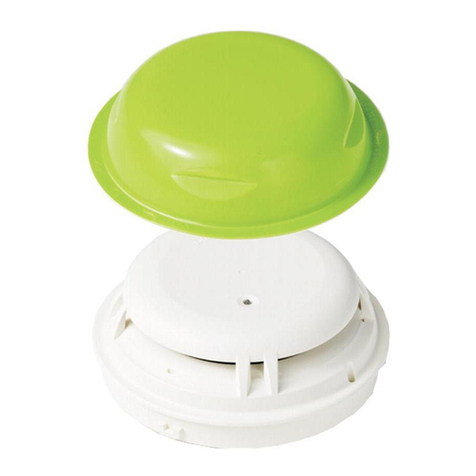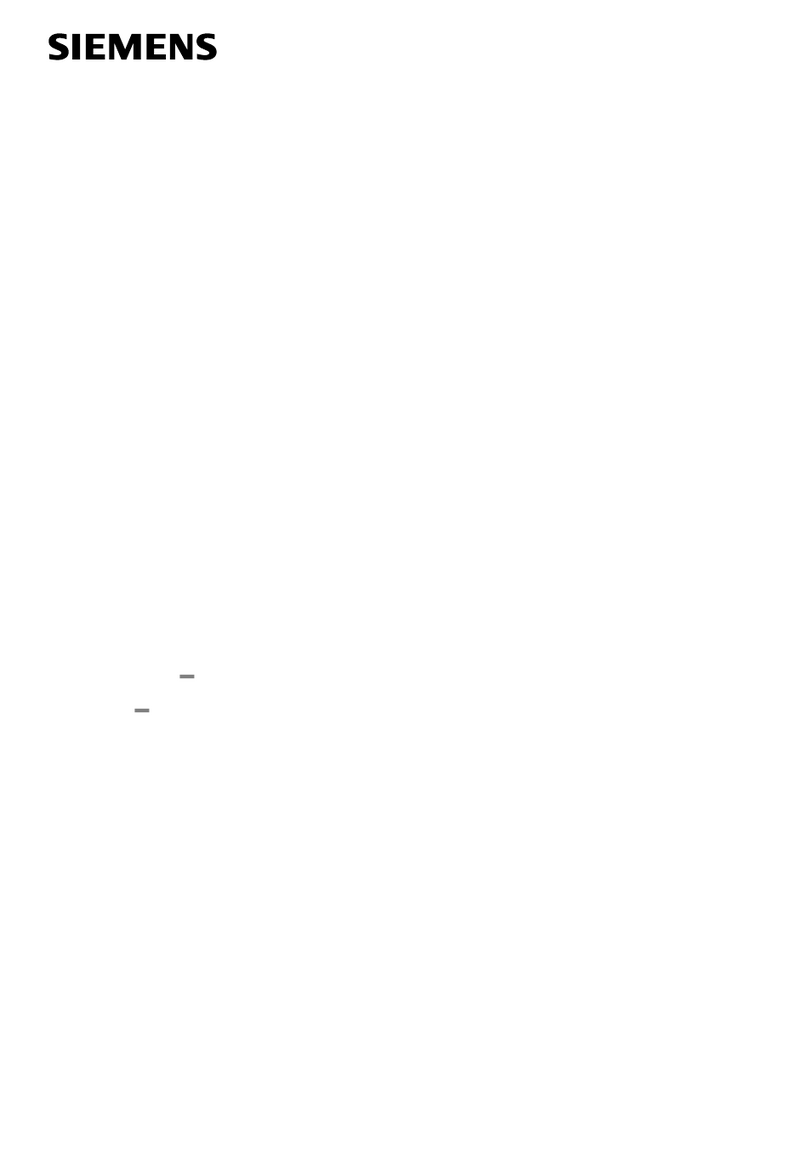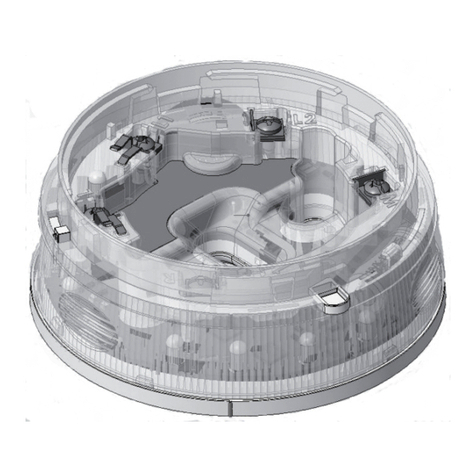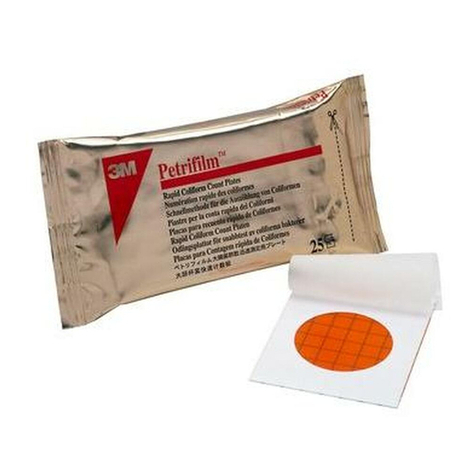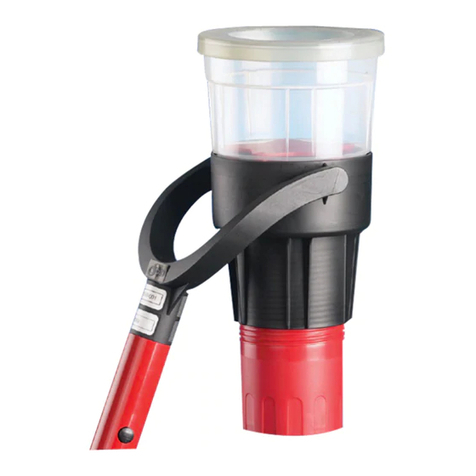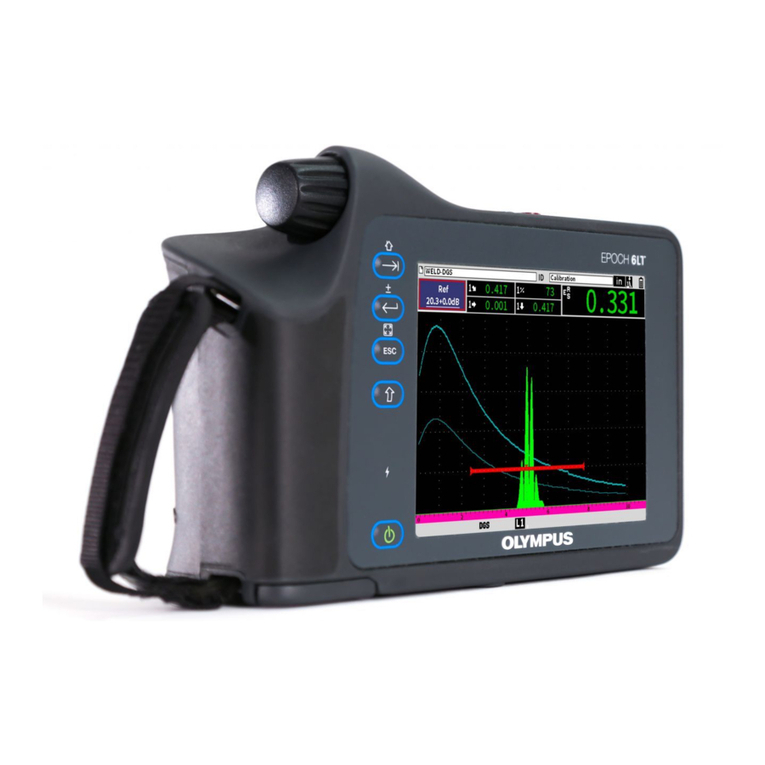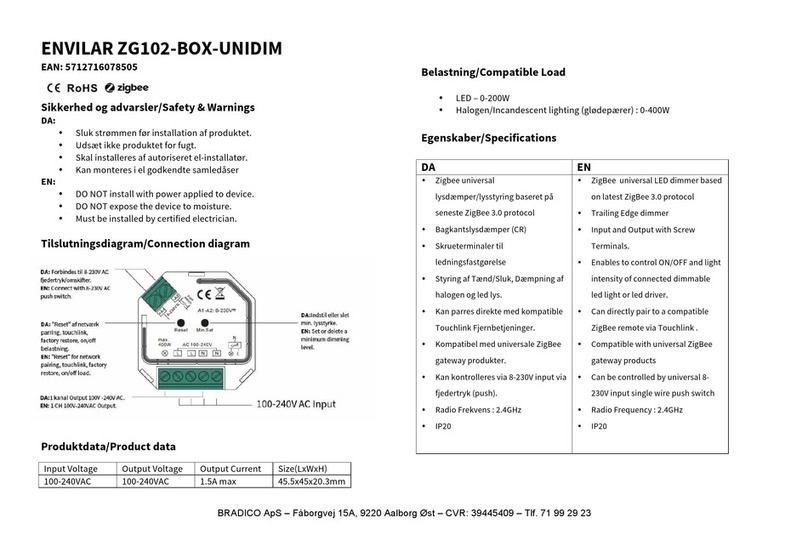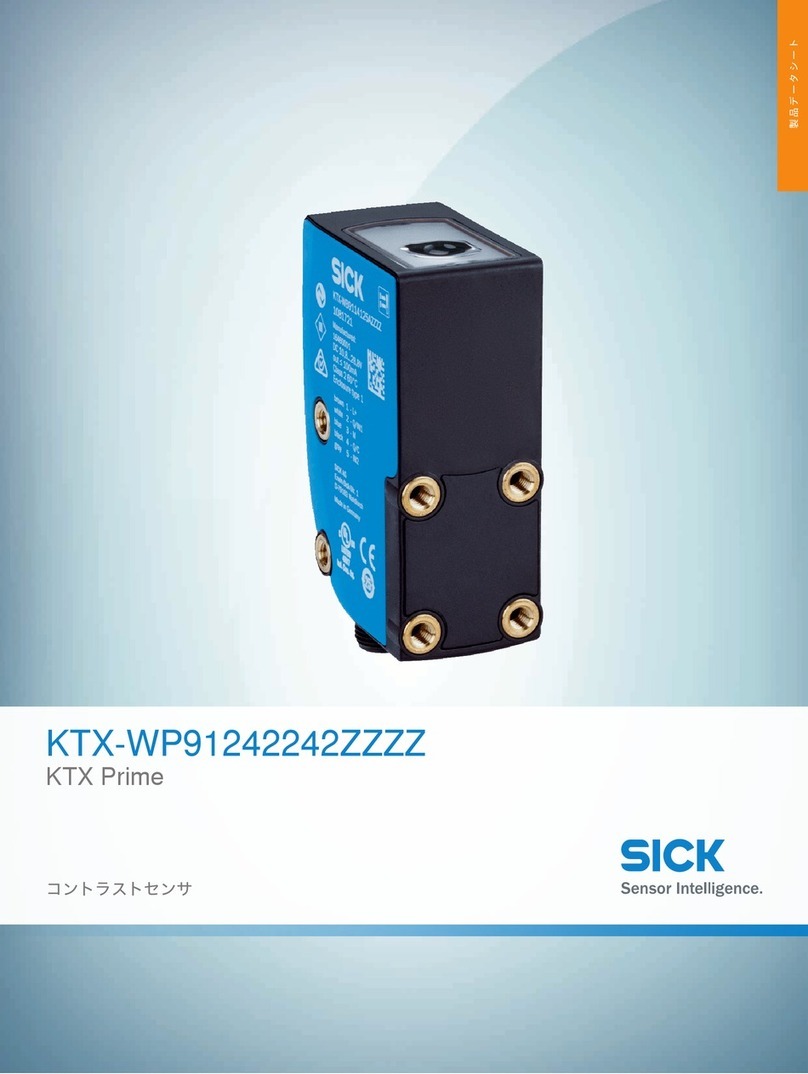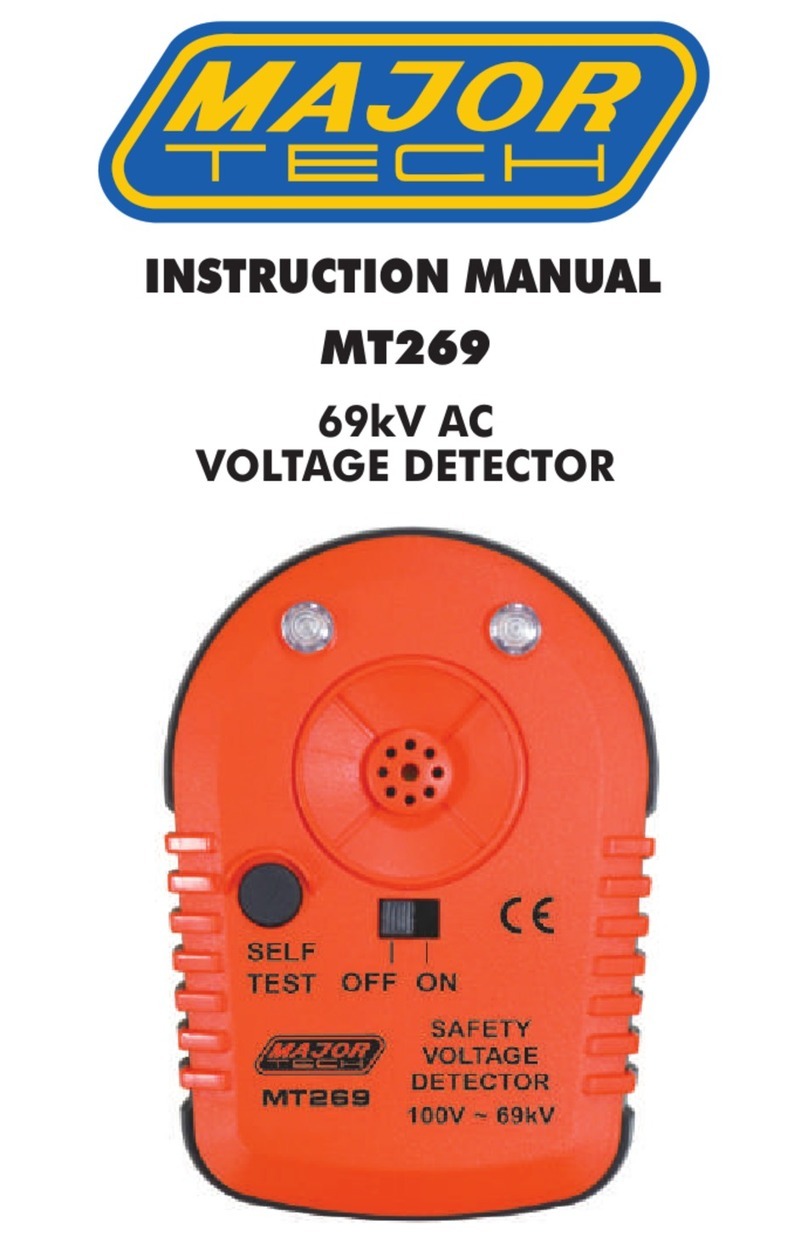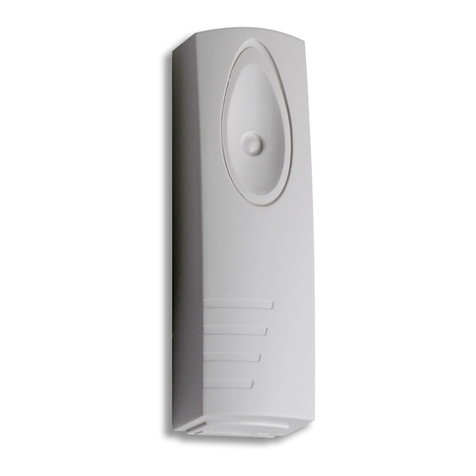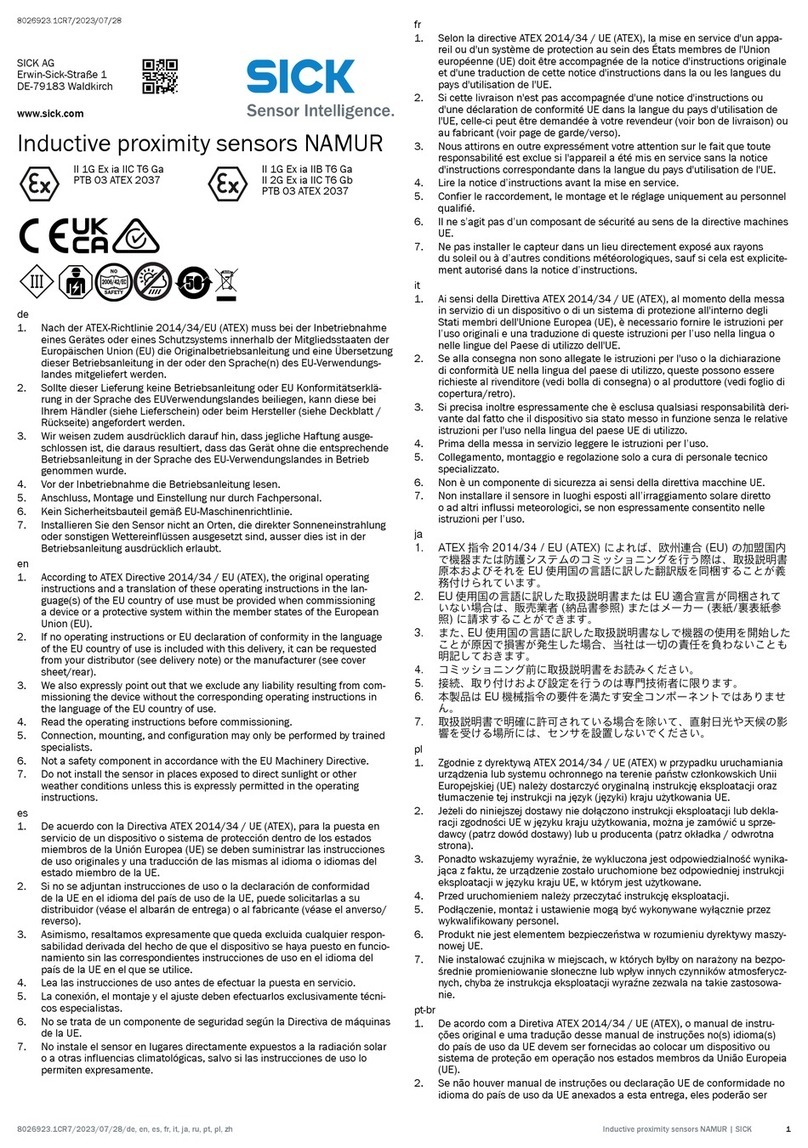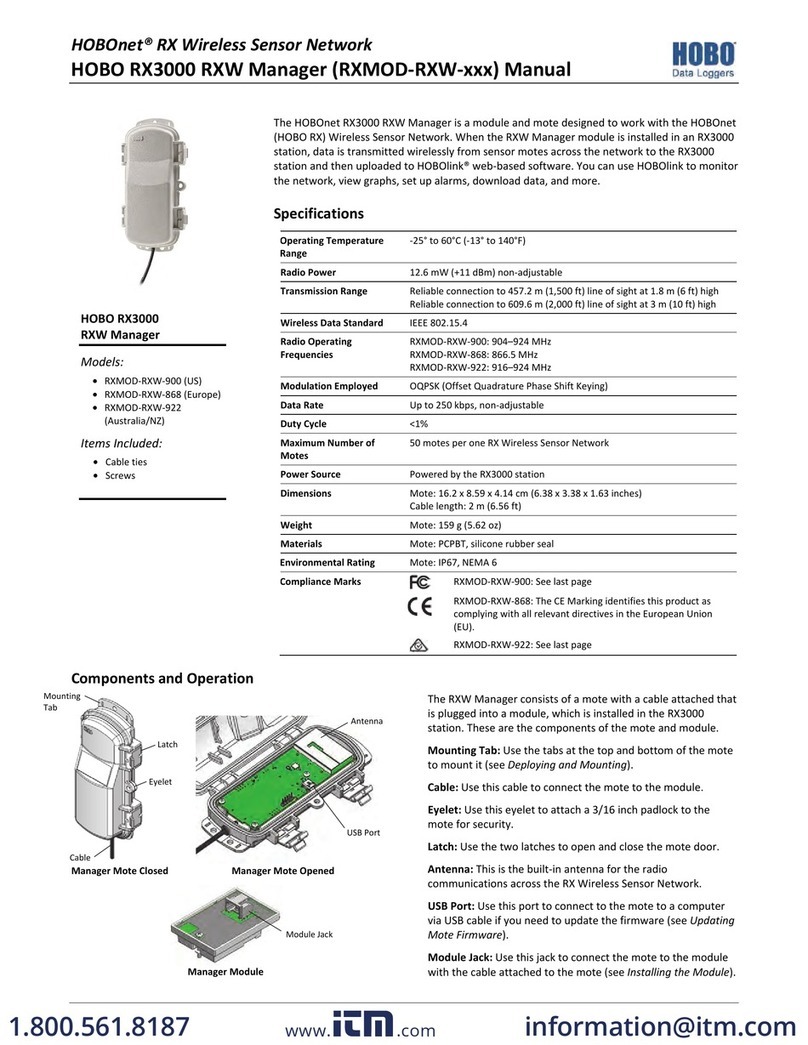Ronstan Safety Rail System S22 User manual

Ronstan International Pty Ltd
19 Park Way, Braeside, Victoria 3195 Australia
Tel: +61 (0)3 8586 2000 Fax: +61 (0)3 8586 2099 Email: office@ronstan.com.au
E.U. Representative: Ronstan Denmark ApS
Jægervænget 36, 7100 Vejle, Denmark
1
ISSUED 22/02/13
SAFETY RAIL SYSTEM S22
Certified to European Standard EN795:2012, Type D: Personal fall protection
equipment –Anchor Devices.
A reliable anchor device is an essential component of any personal protection system.
This system provides a method of attachment for use in conjunction with personal protection
equipment to protect against falls from a height, such as when working outside of
conventional guardrails for cleaning and maintenance purposes. It shall not be used for
lifting equipment or for any other purpose.
Important Advice
The system is tested and certified to the European Standard EN795;2012 Type D by Lloyd’s
Register, Copenhagen (Denmark), and is appropriate for single person use only.
This anchor device is designed for the attachment of components of a personal fall protection
system (harnesses, lanyards, fall arresters and other devices) in accordance with EN363,
Personal fall protection equipment –Personal fall protection systems.
Each harness or device must be secured to a separate attachment point.
If this anchor device is to be used as part of a fall arrest system, the user must be equipped with
a means of limiting the maximum dynamic forces exerted on the user during the arrest of a fall to
a maximum of 6KN.
System Description
The complete Safety Rail System consists of the following components:
One track rail with stop holes at 50mm centres and mounting holes at 100mm (3 15/16”)
centres.
One tandem sliding car assembly consisting of two cars joined together with a connecting
plate.
oEach car has a single attachment point for personal protection equipment.
oOne of the cars has a spring-loaded plunger to allow the assembly to be fixed in
position at any of the stop holes in the track rail. This plunger can be disengaged to
allow the free movement of the car assembly along the rail.
Two end stops installed at the extremities of the track rail.

Ronstan International Pty Ltd
19 Park Way, Braeside, Victoria 3195 Australia
Tel: +61 (0)3 8586 2000 Fax: +61 (0)3 8586 2099 Email: office@ronstan.com.au
E.U. Representative: Ronstan Denmark ApS
Jægervænget 36, 7100 Vejle, Denmark
2
ISSUED 22/02/13
Plunger up and locked,
car free to move along
track rail
Features
Marine grade aluminium alloy cars, track rails and end stops, anodised for corrosion protection
and long service life.
Recirculating Torlon®ball bearings for free running, low friction performance and low
maintenance. (Torlon®is a registered trademark of Solvay Advanced Polymers).
Grade 316 forged stainless steel pivoting shackles for lanyard attachment.
Rubber buffers for reduced vibration and to lift pivoting shackles away from car body for quick
access.
Spring-loaded stainless steel plunger for simple, positive re-positioning at stop locations. Can
be locked in the disengaged position to allow free movement along the track rail. The elliptical
knob is easy to grip and turn, and indicates clearly whether the plunger is engaged or not.
The track rail can be mounted in either a vertical plane (90°), horizontal plane (0°) or at an
incline between 0° and 90° as shown below.
Options
Longer runs can be achieved by using more than one section of track rail and trimming to
length as required, provided that the distance between mounting fasteners never exceeds
100mm (3 15/16”). The joining insert RC1221J is used to aid alignment when fitting multiple
sections of track rail.
Additional sliding cars for supporting tools or equipment can be connected to the main tandem
car RCC22-2 with the connector plate RCC22-4.
Cover plate RC12281PS can be fitted to the track end stop RC12281S with the screws
provided to conceal the exposed end of the track.
Plunger down, fixed
in position
Plunger up, ready to
move to new position
RC12281S
End stop
RCC22-2
Tandem Car
RCC22-3 & RCC22-4
(Optional Equipment Car &
Connector Plate)
RC1220-3.0S
Track Rail
Lanyard
Attachment Points

Ronstan International Pty Ltd
19 Park Way, Braeside, Victoria 3195 Australia
Tel: +61 (0)3 8586 2000 Fax: +61 (0)3 8586 2099 Email: office@ronstan.com.au
E.U. Representative: Ronstan Denmark ApS
Jægervænget 36, 7100 Vejle, Denmark
3
ISSUED 22/02/13
System Components
Part No.
Description
Length
Width
mm
in
mm
in
RCC22-2
Tandem Car, 2 Attachment Points, Plunger Stop
254
10
58
2 5/16
RCC22-1
Single Car, 1 Attachment Point, Plunger Stop
124
4 7/8
58
2 5/16
RCC22-3
Single, Car, 1 Attachment Point
124
4 7/8
58
2 5/16
RCC22-4
Connector Plate including Screws
RC12281S
Track Rail End Stop
48
1 29/32
47
1 27/32
RC12281PS
End Stop Cover Plate including screws
RC1221J
Track Rail Joiner
RC1220-3.0S
Track Rail
2996
118
22
7/8
RC1221J
RCC22-2
RC12281S
RCC22-1
RC1220-3.0S
RCC22-3
RCC22-4
RC12281PS

Ronstan International Pty Ltd
19 Park Way, Braeside, Victoria 3195 Australia
Tel: +61 (0)3 8586 2000 Fax: +61 (0)3 8586 2099 Email: office@ronstan.com.au
E.U. Representative: Ronstan Denmark ApS
Jægervænget 36, 7100 Vejle, Denmark
4
ISSUED 22/02/13
Installation
The Anchor Device should only be installed by competent persons or competent organisations.
The installation should be verified appropriately (eg: by calculation and/or testing).
Note must be taken of the maximum loads that could be exerted on the structure and fasteners by the
anchor device as detailed below.
It is recommended that the structure used to hold the fasteners is stiff enough to ensure there is no
failure of either the fastener or structure at these maximum loads as well as ensuring there is no
permanent deformation or deflection of the anchor system under the service load of 1KN.
Consideration should also be given to the material used in the structure so that it does not cause
corrosion in either the fastener or the structure. Isolation between the fastener and the structure may
be required.
The track rail must be mounted using 6mm (1/4”) countersunk Grade 316 Stainless Steel fasteners at
100mm (3 15/16”) centres. It is recommended that these fasteners have a minimum strength of 620MPa
to meet the load requirements detailed below.
The track rail must be mounted horizontally (i.e. parallel to water plane), within a tolerance of ±5°.
End stops must be mounted using 6mm (1/4”) countersunk Grade 316 Stainless Steel fasteners.
Maximum loads that could be transmitted in service from the anchor device to the structure are:
Horizontal Plane Vertical Plane
The RCC22-2 tandem car is supplied with ball bearings already fitted, on a short loading track rail. To
install the car, first remove the RC12281S end stop from the end of the installed track rail. Align the
loading track rail with the installed track rail such that they are in contact with each other end-to-end,
then slide the car onto the installed track rail and fit the end stop back in place. DO NOT discard the
loading track rail, which is required for retaining the ball bearings while installing or removing the car.
If the sliding car cannot pass through a discontinuity in the track (eg: Track ending before a sharp
corner, then starting again around the corner), a second car must be available after the track
discontinuity. The user must always be attached to at least one car when using the anchor device.
If the marking of the anchor device is not accessible after installation, additional marking near the
anchor device is recommended.
M=266.4Nm
x
y
Fy=12KN
22.2mm
12KN
12KN
Fy=12KN
Load
Reaction
Force/Moment

Ronstan International Pty Ltd
19 Park Way, Braeside, Victoria 3195 Australia
Tel: +61 (0)3 8586 2000 Fax: +61 (0)3 8586 2099 Email: office@ronstan.com.au
E.U. Representative: Ronstan Denmark ApS
Jægervænget 36, 7100 Vejle, Denmark
5
ISSUED 22/02/13
Installation Documentation
For the user, the installation documentation provides evidence that the installation has been carried out
properly. Moreover, it is the essential basis for future examination of the anchor device, given that in many
cases the fixing of the anchor device is not visible or accessible.
After Installation, copies of the installation documentation should be handed over to the user. This
documentation should be kept on site for the purpose of subsequent examinations of the anchor device.
Refer to APPENDIX A for the Installation Plan which must be completed by the installer.
Use and Maintenance
Labels are affixed to each individual car by the manufacturer.
oOne label indicates the standard (EN795:2012 Type D) to which the product conforms.
oA second label indicates the part number and date of manufacture, which must be referred to in
all communication with the manufacturer or its authorised representatives.
oA third label (fixed to cars with plunger stop) indicates that the car is for single person use only.
If re-sold outside the original country of destination, it is essential for the safety of the user that the
reseller provide all information relating to the installation, use, maintenance, periodic examinations and
service of the system in the language of the country of destination.
Each user must read and understand this user manual prior to first use of the system.
As with any workplace where hazards may be present, an appropriate rescue plan shall be in place for
any emergencies that may arise during work involving the system.
The system must be used only in conjunction with personal protective equipment approved to relevant
standards.
The user must NEVER rely on only one attachment point for personal protective equipment!
The spring loaded plunger which locks the car in position along the track rail must ONLY be disengaged
from the track rail while the user is changing position. Once the user is in position, the plunger MUST be
re-engaged to hold the car in position and limit the user’s movement along the track rail.
For the safety of users, a visual inspection of the system must be carried out by a competent person
before each use to verify the following conditions:
oThe track rail is securely fixed to its mounting surface and both end stops are in place at the
extremities.
oThe sliding cars run smoothly and freely on the track rail.
oThe lanyard attachment points (pivoting shackles) are free to articulate. (Any deformation in the
shackle indicates a fall or overload of the anchor device and it must be replaced).
oThere are no signs of excessive wear, corrosion, deformation or breakage of parts.
oThe plunger used to fix the car in position is operating correctly.
oAll screws in the sliding car assembly are in place and secure.
It is recommended that the complete system be inspected annually by a competent person. In addition
to verification of the conditions noted above, the cars shall be removed from the installed track rail and
the following checks performed:
oTo remove a car from the track rail, use the short loading track rail that was originally supplied
with the car. (If no loading track is available, contact the manufacturer before proceeding).
oOnce the car is transferred to the loading track rail, the recirculating ball bearings can be
inspected from the underside of the car.
oA small screwdriver may be used to push the ball bearings to verify that they are free to
circulate.
oIf all ball bearings are present, the balls can be pushed together to leave a space slightly less
than one ball diameter. A larger space indicates that one or more balls are missing. Each
individual car in the RCC22-2 tandem assembly (and the individual cars RCC22-1 and
RCC22-3) must contain a total of 74 ball bearings.
oAny ball bearings that are missing, or that appear worn or cracked, must be replaced. Use only
replacement ball bearings supplied by the manufacturer.
oThe plunger assembly may be lubricated with a light grease. Lift the spring loaded plunger and
apply grease to the exposed rod below the elliptical knob.
oThe manufacturer should be contacted if the labels on any car are found to be missing or
illegible.

Ronstan International Pty Ltd
19 Park Way, Braeside, Victoria 3195 Australia
Tel: +61 (0)3 8586 2000 Fax: +61 (0)3 8586 2099 Email: office@ronstan.com.au
E.U. Representative: Ronstan Denmark ApS
Jægervænget 36, 7100 Vejle, Denmark
6
ISSUED 22/02/13
In case of any doubts about the condition of the system, or if any component is found to be damaged in
any way, the parts must be immediately removed from service. The system must not be used until
repairs are completed and approved in writing by a competent person.
No changes or alterations may be made to the components of the system without the manufacturer’s
prior written consent. Any repair must be carried out according to the manufacturer’s procedures.
After any fall, the system must not be used until it has been inspected and a competent person has
confirmed in writing that it is safe to do so.
Regular rinsing of all components with fresh water is required to help to prevent the build up of salt and
contaminants and ensure efficient operation of the system.
Spray lubricants should not be used on the rail and ball bearings as they can lead to accumulation of
contaminants and dirt which will compromise the long term performance of the system.
Record Keeping
It is recommended that the anchor device is marked with the date of the next or last inspection.
It is recommended that a record be kept for each component of the system, with particular regard to
installation, inspection, maintenance and service interventions.
Refer to APPENDIX B for the Equipment Record sheet that should be filled out for each component of the
system by the competent person inspecting the safety rail system. This forms an inspection, maintenance
and repair history for each component of the system.
If any component of the system is inspected or repaired by Ronstan authorised personnel, a Ronstan
Record of Inspection and Revision sheet will be completed. This is to be kept by the user with the
Equipment Record and form the Inspection and Maintenance History for the system.
Refer to APPENDIX C for the Annual Inspection and Revision procedure and record sheet.
Re-Seller Contact Details
If the system or any of its components have been supplied by a company or organisation other than the
manufacturer, contact details of the supplier may be recorded in the space below:

Ronstan International Pty Ltd
19 Park Way, Braeside, Victoria 3195 Australia
Tel: +61 (0)3 8586 2000 Fax: +61 (0)3 8586 2099 Email: office@ronstan.com.au
E.U. Representative: Ronstan Denmark ApS
Jægervænget 36, 7100 Vejle, Denmark
7
ISSUED 22/02/13
APPENDIX A
SAFETY RAIL SYSTEM INSTALLATION PLAN
BUILDING/VESSEL
NAME: ADDRESS:
DESCRIPTION:
CUSTOMER
NAME: CONTACT PERSON:
ADDRESS: CONTACT DETAILS:
INSTALLER
NAME: CHIEF INSTALLER:
ADDRESS: CONTACT DETAILS:
ANCHOR DEVICE
MANUFACTURER: ADDRESS: Jægervænget 36
Ronstan Denmark ApS 7100 Vejle, Denmark
DESCRIPTION: CONTACT DETAILS: Ph) +45 76 42 77 77
Series 22 Safety Rail System office@ronstan.dk www.ronstan.com
CAR PART NUMBER(S) AND DATES OF MANUFACTURE:
(this information can be found on product labels) NUMBER OF CARS USED:
LENGTH OF TRACK USED: (m)
FIXING INFORMATION:
Fastener Description: Fastener Strength:
Fastener Manufacturer:
Torque used to install fasteners:
Description of substrate structure that fasteners are fixed to:
Were nuts and washers used?
If not, how are fasteners fixed to substrate?
Is the threaded end of the fastener able to be accessed for inspection and maintenance?
Remarks:
NOTE: THIS MUST BE HANDED OVER TO THE USER AFTER INSTALLATION, COPIES MUST BE DISPLAYED AT ALL
ACCESS POINTS TO THE SAFETY RAIL SYSTEM.

Ronstan International Pty Ltd
19 Park Way, Braeside, Victoria 3195 Australia
Tel: +61 (0)3 8586 2000 Fax: +61 (0)3 8586 2099 Email: office@ronstan.com.au
E.U. Representative: Ronstan Denmark ApS
Jægervænget 36, 7100 Vejle, Denmark
8
ISSUED 22/02/13
(SAFETY RAIL SYSTEM INSTALLATION PLAN CONTINUED)
DECLARATION:
I, as the Chief Installer, declare that the Safety Rail Anchor System:
- was installed in accordance with the manufacturer's manual and installation instructions.
- was carried out according to this plan.
- was fixed to the specified structure and substrate in the method described.
- was fixed using the fasteners as specified.
- was commissioned in accordance with the manufacturer's information.
- was installed and commissioned in accordance with any additional relevant standards.
(examples are: EN795:2012, Personal fall protection equipment - Anchor Devices
MGN422(M) - Use of equipment to undertake work over the side on yachts and other vessels.)
- was supplied with photographic information/documentation, especially where fasteners
and the underlying substrate are no longer visible after installation.
- installation was verified appropriately by calculation and/or testing.
- was installed to meet the load requirements as detailed in the Manufacturer's Installation Instructions
Date: Signature:

Ronstan International Pty Ltd
19 Park Way, Braeside, Victoria 3195 Australia
Tel: +61 (0)3 8586 2000 Fax: +61 (0)3 8586 2099 Email: office@ronstan.com.au
E.U. Representative: Ronstan Denmark ApS
Jægervænget 36, 7100 Vejle, Denmark
9
ISSUED 22/02/13
APPENDIX B
Date of First Use:
Date
Type of intervention
(periodic inspection,
maintenance or repair)
Details
(defects, repairs, other)
Name/Signature of
Competent Person
Date of next periodic
inspection
Product:
SAFETY RAIL SYSTEM S22
Part Number:
EQUIPMENT RECORD
Manufacturer:
Ronstan Denmark ApS
Jægervænget 36
7100 Vejle, Denmark
Contact Details
+45 76 42 77 77
www.ronstan.com
PERIODIC INSPECTION, MAINTENANCE AND REPAIR HISTORY
Year of Manufacture:
Date of Purchase:
Other Relevant Information
(e.g. document number, details of supplier or installer):

Ronstan International Pty Ltd
19 Park Way, Braeside, Victoria 3195 Australia
Tel: +61 (0)3 8586 2000 Fax: +61 (0)3 8586 2099 Email: office@ronstan.com.au
E.U. Representative: Ronstan Denmark ApS
Jægervænget 36, 7100 Vejle, Denmark
10
ISSUED 22/02/13
APPENDIX C
Safety Rail Cars
Procedure for Annual Inspection and Revision
Inspection of working track(s) and end stops to ensure all fastenings are secure and
there are no signs of damage.
Removal of car from track.
Visual inspection to identify any worn, deformed or damaged parts.
Verification of plunger stop functionality.
Disassembly of car including removal of ball bearings and pivoting shackle.
Visual inspection of disassembled car for signs of corrosion, and inspection of shackle
pin for wear.
Fresh water cleaning and removal of any contaminants.
Replacement of Torlon ball bearings if required.
Replacement of rubber buffers if required.
Lubrication of plunger stop.
Replacement of any other worn or damaged components (note details below if
applicable).
Re-assembly of car on loading track.
Installation of car on working track; verify again that end stops are properly secured.
Recording of inspection and revision in the Equipment Record, appendix B in the User
Manual.
Notes:
Part Number
Description
Quantity
Label Reference
Date: _______________________________
Location: _______________________________
Inspected by: _______________________________
Table of contents
